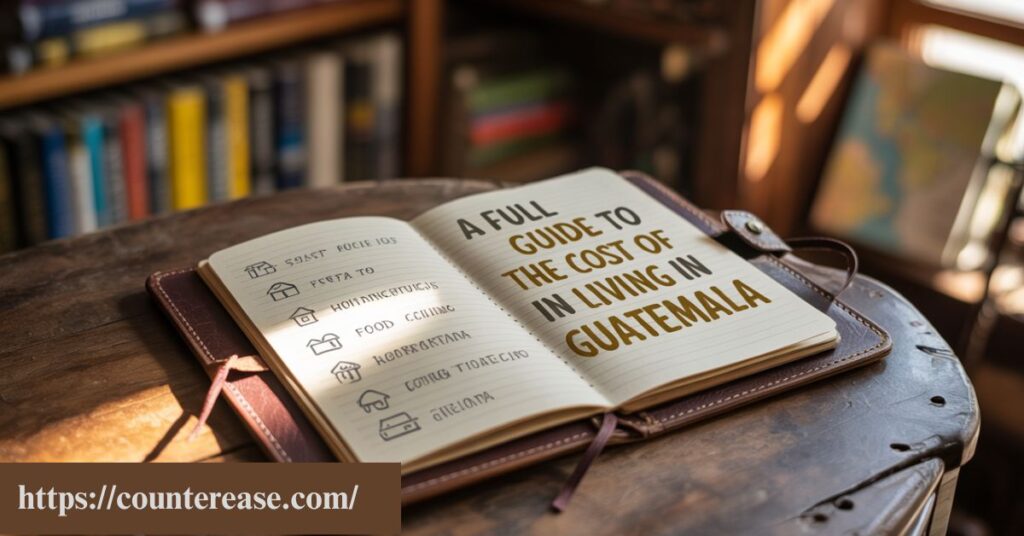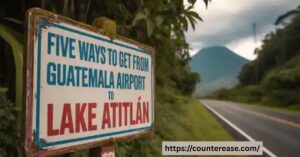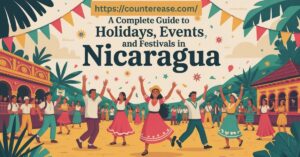Tucked into the heart of Central America, Guatemala offers a rich tapestry of Mayan heritage, vibrant markets, and breathtaking landscapes—all at a surprisingly affordable cost. The “cost of living guatemala guide” refers to the everyday expenses one incurs while residing or traveling through this culturally diverse nation, including housing, food, transportation, healthcare, and leisure. Whether you’re a digital nomad, retiree, backpacker, or long-term traveler, understanding these costs can help shape an unforgettable and budget-friendly experience.
Imagine sipping fresh Guatemalan coffee on a lakeside terrace in Panajachel, exploring ancient ruins in Tikal, or wandering the cobblestone streets of Antigua—all without burning through your savings. This cost of living guatemala guide brings you real, local insights into what daily life in Guatemala truly costs. With its low expenses and high quality of life, Guatemala is quickly becoming a top choice for expats and adventure seekers alike.
From $2 street meals to scenic $10-a-night hostels, Guatemala balances value with experience like few countries can. This guide dives deep into the true cost of living—from big cities like Guatemala City to peaceful gems like Lake Atitlán. Whether you’re planning a short stay or considering long-term relocation, this comprehensive breakdown will help you budget wisely and live well in one of Central America’s most charming destinations.
Guatemala Cost of Living 2025: What You’ll Really Spend
Guatemala has emerged as one of Central America’s most compelling destinations for budget-conscious expats, digital nomads, and retirees seeking affordable living without sacrificing quality of life. With the Guatemalan Quetzal (GTQ) offering exceptional purchasing power against the US dollar, this vibrant country presents opportunities for comfortable living at a fraction of Western costs.
The cost of living in Guatemala varies dramatically depending on your lifestyle choices and location preferences. While backpackers can survive on $400 monthly, families seeking comfort typically budget $1,500-$2,500. This comprehensive cost of living guatemala guide breaks down real expenses across every category, helping you make informed decisions about your potential move.
Why Guatemala Captivates Budget-Conscious Expats
Guatemala’s affordability stems from several economic factors that create favorable conditions for foreign residents. The country’s lower wage structure translates into reduced service costs, while abundant local produce keeps food expenses minimal. Unlike tourist-heavy destinations, Guatemala maintains authentic pricing in most regions.

Recent economic stability has attracted a growing digital nomad community, particularly around Antigua, Lake Atitlán, and Quetzaltenango (Xela). These areas offer reliable internet, established expat communities, and infrastructure supporting remote work.
The country’s diverse geography provides options for every budget. Smaller towns offer ultra-affordable living, while tourist hubs provide Western amenities at reasonable premiums. This flexibility allows residents to find their perfect balance between cost and comfort.
Guatemala’s Currency Landscape: The Quetzal Reality
The Guatemalan Quetzal (GTQ) typically trades between 7.5-8.0 per US dollar, though exchange rates fluctuate based on global economic conditions. Cash transactions dominate daily life, with many vendors offering better prices for quetzals over dollars.
ATM withdrawal fees represent a significant expense for expats. Most banks charge $3-$5 per transaction, plus your home bank’s international fees. Smart money management involves larger withdrawals to minimize fee impact.
Card payment fees range from 5-10% at many establishments, making cash the preferred payment method. However, upscale restaurants and tourist-oriented businesses readily accept cards. Carrying both currencies provides maximum flexibility for daily transactions.
| Payment Method | Best Use Cases | Typical Fees |
|---|---|---|
| Cash (GTQ) | Local markets, street food, buses | None |
| Cash (USD) | Tourism services, some rent | 2-5% worse exchange |
| Debit/Credit Cards | Hotels, upscale dining, online | 5-10% processing fees |
Regional Cost Breakdown: Guatemala Isn’t One-Size-Fits-All
Guatemala City: Urban Convenience with Metropolitan Prices
The capital offers the highest earning potential but commands premium pricing. Monthly living costs range $800-$2,000 depending on neighborhood choice. Zone 10 and Zone 14 cater to affluent residents with prices approaching international levels.
Transportation costs increase significantly in the capital. Taxis and Uber replace walking, adding $100-$200 monthly to budgets. However, job opportunities and urban amenities offset higher expenses for career-focused expats.
Antigua: Tourist Premium vs. Authentic Neighborhoods
Antigua Guatemala attracts tourists and expats with its colonial architecture and UNESCO World Heritage status. Central locations command $600-$1,500 monthly rent, while peripheral neighborhoods offer $300-$600 options.
Restaurant prices reflect tourist demand, with meals costing 50-100% more than other regions. Smart residents shop at local markets and cook frequently, maintaining reasonable food budgets despite location premiums.
Lake Atitlán: Lakeside Living Costs Across Different Towns
Lake Atitlán’s various towns offer distinct cost structures. Panajachel provides urban conveniences at moderate prices, while San Pedro La Laguna attracts backpackers with rock-bottom expenses. San Marcos appeals to wellness-focused expats seeking higher-end options.
Transportation between lakeside communities relies on boat services costing $1-$3 per trip. This cost of living guatemala guide unique geography creates micro-economies where each town develops its own pricing culture.
Xela (Quetzaltenango): Student-Friendly Mountain City Economics
Quetzaltenango, known locally as Xela, offers Guatemala’s best value proposition for educated expats. The city’s university atmosphere keeps costs low while providing cultural sophistication. Monthly expenses rarely exceed $800 for comfortable living.
Spanish language schools proliferate here, creating income opportunities for qualified teachers. The cooler mountain climate reduces utility costs compared to tropical regions.
Housing: Your Biggest Monthly Investment
Rental Market Deep-Dive
Housing costs typically consume 25-40% of monthly budgets, making location choice critical for financial success. Studio apartments range from $150 in rural areas to $800 in prime Antigua locations.
One-bedroom apartments offer the sweet spot for solo expats, ranging $200-$1,200 across regions. Guatemala City’s modern zones command highest prices, while colonial cities offer character at premium costs.
Family homes accommodate larger groups or those seeking space and privacy. Expect $300-$2,000+ monthly depending on location, size, and amenities. Gated communities add security but increase costs significantly.
| Housing Type | Budget Range | Mid-Range | Luxury |
|---|---|---|---|
| Studio Apartment | $150-$300 | $300-$500 | $500-$800 |
| One Bedroom | $200-$400 | $400-$700 | $700-$1,200 |
| Two Bedroom | $300-$600 | $600-$1,000 | $1,000-$1,800 |
| Family Home | $400-$800 | $800-$1,500 | $1,500-$3,000+ |
Hidden Housing Costs
Security deposits typically equal 1-2 months’ rent, with some landlords requiring additional guarantees. Utility setup fees can reach $100-$200 for electricity and water connections.
Maintenance responsibilities vary by rental agreement. Many properties require tenant-funded repairs, making handyman relationships valuable. Property management fees in expat-heavy areas add 10-15% to advertised rents.
Food Economics: Markets to Restaurants
Local Market Shopping
Traditional markets provide exceptional value for fresh produce, with weekly grocery budgets ranging $25-$60 for individuals. Corn, beans, and tortillas form the dietary foundation, offering excellent nutrition at minimal cost.
Market meals or comedores serve complete lunches for $2-$4, including protein, vegetables, and tortillas. These establishments cater to working locals, ensuring authentic flavors and honest pricing.
Self-catering dramatically reduces food expenses. Cooking equipment represents a one-time investment that pays dividends through significant savings compared to restaurant dining.
Restaurant Spectrum Analysis
Street food provides delicious meals for $1-$3, from breakfast tamales to evening tacos. Quality varies, but established vendors with local customer bases typically offer safe, tasty options.
Mid-range restaurants charge $8-$15 for complete meals, often featuring traditional Guatemalan dishes like Pepián or rellenitos. These establishments balance authenticity with tourist comfort expectations.
Western restaurants command $15-$40 for familiar cuisines, primarily concentrated in expat areas. While expensive locally, prices remain reasonable compared to North American standards.
| Dining Category | Price Range | Best Value Locations |
|---|---|---|
| Street Food | $1-$3 | Market areas, bus terminals |
| Local Comedores | $2-$4 | Residential neighborhoods |
| Mid-Range Local | $8-$15 | Town centers, tourist areas |
| Western Cuisine | $15-$40 | Antigua, Zone 10 Guatemala City |
Transportation: Getting Around Without Breaking Bank
Public Transportation Mastery
Chicken buses represent Guatemala’s iconic transportation backbone, connecting cities for $2-$8 depending on distance. These colorfully decorated former school buses provide authentic cultural experiences alongside rock-bottom pricing.
Urban buses serve city routes for $0.25-$0.50 per ride, though comfort and safety vary significantly. Tuk-tuks offer short-distance convenience for $1-$3, popular for market trips and tourist areas.
Shuttle buses cater to tourists and expats with higher comfort levels, charging $10-$25 for intercity routes. These cost of living guatemala guide services trade authentic experience for predictable schedules and air conditioning.
Vehicle Ownership Economics
Car ownership involves significant upfront investment plus ongoing expenses. Used vehicles cost $5,000-$20,000, with import duties adding substantial premiums for newer models.
Insurance costs range $300-$800 annually, while fuel expenses currently hover around $4.50 per gallon. Maintenance costs remain reasonable due to abundant mechanical services.
Motorcycle ownership offers compelling economics for solo travelers, with used bikes available from $1,000-$5,000. Fuel efficiency and easy parking make motorcycles ideal for navigating Guatemala’s challenging road conditions.
Essential Services: Utilities and Connectivity
Electricity and Water
Electricity bills fluctuate seasonally, ranging $30-$150 monthly depending on usage patterns and climate. Air conditioning dramatically increases costs in tropical regions, while highland locations rarely require cooling.
Water services cost $10-$40 monthly for municipal connections. Bottled water remains essential for drinking, adding $15-$30 monthly to budgets. Water filtration systems reduce long-term costs while improving convenience.
Internet speeds vary significantly by location and provider. Basic residential service costs $25-$50 monthly, while business-grade connections required for digital nomad work range $50-$100.
Communication Services
Mobile phone plans offer excellent value, with unlimited local calling and substantial data packages available for $15-$40 monthly. International calling requires additional fees or VoIP alternatives.
Landline services cost $15-$25 monthly but provide reliability during storms and emergencies. Many expats maintain both mobile and landline services for redundancy.
| Utility | Basic | Moderate | High Usage |
|---|---|---|---|
| Electricity | $30-$60 | $60-$100 | $100-$150+ |
| Water | $10-$20 | $20-$30 | $30-$40+ |
| Internet | $25-$35 | $35-$50 | $50-$100+ |
| Mobile Phone | $15-$25 | $25-$35 | $35-$50+ |
Healthcare: Quality Care on a Budget
Private Healthcare Excellence
Private healthcare in Guatemala offers exceptional value compared to US costs. Doctor consultations range $15-$40, while specialist visits cost $30-$80. Many physicians trained internationally provide world-class care at fraction of Western prices.
Dental care represents particular value, with routine cleanings costing $25-$40 and major procedures priced 60-80% below US equivalents. Many Americans travel specifically for dental tourism.
Prescription medications cost significantly less than US prices, especially generic alternatives. Most medications available without prescriptions, though quality varies between pharmacies.
Health Insurance Options
Travel insurance suffices for short-term stays, costing $50-$150 monthly depending on age and coverage levels. Local insurance plans offer comprehensive coverage for $100-$300 monthly.
IGSS (Guatemala’s social security system) provides basic coverage for legal residents, though private insurance ensures better access and shorter wait times.
Sample Monthly Budgets: Real-World Scenarios
Ultra-Budget Backpacker: $400-$600/Month
Housing: Hostel dorms or shared apartments ($100-$200) Food: Market shopping and comedores ($80-$120) Transportation: Chicken buses and walking ($20-$40) Utilities: Shared costs ($15-$30) Entertainment: Free activities and cheap beer ($30-$60) Miscellaneous: Personal items, laundry ($25-$50)
This budget requires careful spending and embracing local lifestyle completely. Slow travel approach works best, staying longer in each location to reduce transportation costs.
Comfortable Digital Nomad: $800-$1,200/Month
Housing: Private apartment or room ($300-$500) Food: Mix of cooking and restaurants ($150-$250) Transportation: Shuttles and occasional taxis ($50-$100) Utilities: Internet, phone, electricity ($80-$120) Entertainment: Tours, dining out, activities ($100-$150) Health: Insurance and medical costs ($50-$100) Miscellaneous: Shopping, personal care ($70-$100)
This budget provides comfort while maintaining significant savings compared to Western living costs. Reliable internet and workspace access support remote work requirements.
Family with Children: $1,500-$2,500/Month
Housing: 2-3 bedroom home with security ($600-$1,200) Food: Family groceries and occasional dining ($300-$500) Transportation: Vehicle ownership or regular shuttles ($200-$400) Education: Private school or tutoring ($200-$600) Utilities: Higher usage for family needs ($150-$250) Healthcare: Family insurance and medical costs ($150-$300) Entertainment: Family activities and travel ($200-$400) Miscellaneous: Clothing, household items ($150-$300)
Family budgets require careful consideration of education quality and safety, often pushing costs toward higher ranges for peace of mind.
Smart Money Strategies: Insider Cost-Cutting Tips

Seasonal Pricing Patterns
Dry season (November-April) brings higher accommodation costs as tourists arrive. Rainy season offers 20-40% discounts on housing and tours, though weather limitations apply.
Christmas and Easter create peak pricing periods when advance bookings become essential. Hurricane season (August-October) provides lowest prices but weather risks.
Negotiation Tactics
Long-term rentals unlock significant discounts, with 6-12 month commitments reducing costs 15-30%. Group bookings for tours and transportation provide leveraging opportunities.
Cash payments often secure 5-10% discounts on services and large purchases. Local currency payments avoid exchange rate markups imposed by dollar-pricing businesses.
Community Resources
Expat communities share resources like bulk purchasing, ride-sharing, and equipment lending. Facebook groups provide insider tips on deals and opportunities.
Volunteer opportunities reduce living costs through housing exchanges or stipends. Many organizations offer room and board for part-time service commitments.
Hidden Costs and Budget Busters
Immigration and Legal Expenses
Tourist visa extensions cost $20-$50 every 90 days, plus border run expenses. Residency applications require substantial documentation fees and legal assistance costing $1,000-$3,000.
Border runs to renew tourist status cost $50-$150 including transportation and fees. Some prefer periodic trips home to avoid visa complications.
Home Country Obligations
US tax obligations continue for American expats, requiring professional preparation costing $500-$2,000 annually. State tax requirements vary and may create additional burdens.
Storage costs for belongings left behind range $50-$200 monthly. Insurance maintenance for vehicles or property adds ongoing expenses many overlook.
Emergency Preparedness
Medical evacuations to US facilities can cost $50,000-$100,000 without proper insurance coverage. Travel insurance with evacuation benefits provides essential protection.
Natural disasters require emergency funds for temporary relocation or property protection. Hurricane and earthquake preparations shouldn’t be underestimated.
Is Guatemala Right for Your Budget?
Guatemala offers exceptional value for those willing to embrace local culture and accept certain infrastructure limitations. Quality of life depends more on adaptability than spending power, with many expats finding fulfillment despite modest budgets.

Safety considerations require ongoing vigilance and sometimes increased expenses for secure housing or transportation. Healthcare quality varies dramatically between public and private options.
Long-term cost trajectory shows gradual increases as tourism develops and infrastructure improves. However, Guatemala remains significantly more affordable than North American alternatives.
The country rewards those who invest time learning Spanish, building local relationships, and adapting to different cultural rhythms. Rushed decisions often lead to overspending and frustration, while patient exploration reveals tremendous opportunities.
Success in Guatemala comes from balancing cost savings with quality of life priorities. Whether seeking adventure on a shoestring budget or comfortable retirement with modern amenities, Guatemala provides options for nearly every financial situation and lifestyle preference.
Your journey begins with honest assessment of priorities, risk tolerance, and adaptability. Guatemala’s cost of living advantages create opportunities for experiences impossible at Western prices, but only for those prepared to embrace the adventure completely.
Frequently Asked Questions: Straight Answers
How much money do you need to live in Guatemala?
Minimum survival requires $400-$600 monthly, while comfortable living costs $800-$1,500. Luxury lifestyles begin around $2,000+ monthly.
Is $100 a lot in Guatemala?
Yes, $100 provides substantial purchasing power locally. It covers 2-3 weeks of basic food expenses or 1-2 months of utility bills in smaller towns.
How much does a Coke cost in Guatemala?
Coca-Cola costs $0.50-$1.00 in local shops, $1.50-$2.50 in restaurants, depending on location and establishment type.
How much is rent in Guatemala per month?
Rent ranges from $150 for basic rural housing to $1,500+ for luxury urban apartments. Most expats pay $300-$800 monthly for comfortable accommodations.
How much does street food cost in Guatemala?
Street food typically costs $1-$3 per meal, with breakfast items like tamales costing $0.50-$1.00 each.
Conclusion
The entral-america guatemala cost-of-living-guatemala-guide shows that life in Guatemala can be both affordable and rewarding. With low prices for housing, food, and transport, it’s a smart choice for travelers, digital nomads, and even retirees. From local markets to budget-friendly rentals, you can enjoy a rich lifestyle without spending much. The guide gives you clear details to plan your trip or move with confidence.
Whether you’re visiting for a month or staying longer, the entral-america guatemala cost-of-living-guatemala-guide helps you understand what to expect. It covers real costs in cities and small towns so you can match your budget with your lifestyle. With the right information, living in Guatemala can be comfortable, safe, and full of adventure.

Asia Jenni is a passionate travel writer and expert author on CounterEase.com. With a deep love for exploration, she shares insightful travel guides, tips, and destination recommendations, helping travelers discover new places with ease. Her expertise in curating memorable trips and her engaging writing style make her a valuable resource for anyone looking to plan their next adventure.








